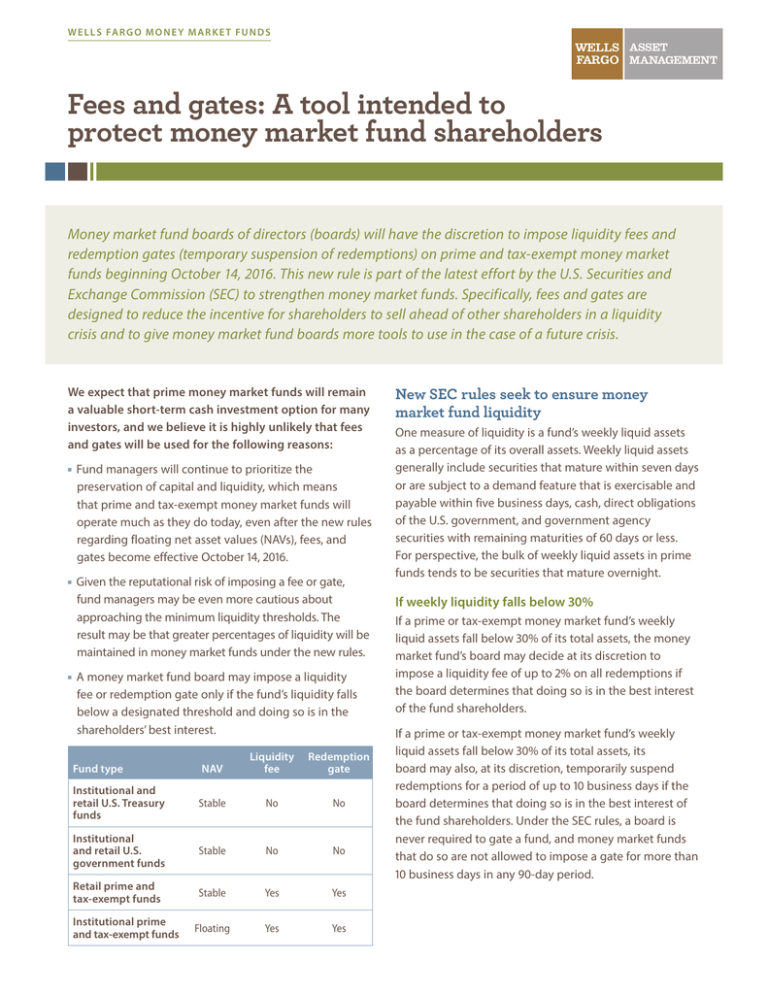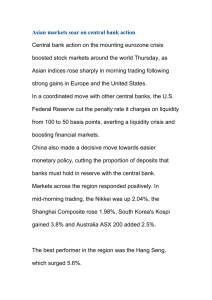
W E L L S FA R G O M O N E Y M A R K E T F U N D S
Fees and gates: A tool intended to
protect money market fund shareholders
Money market fund boards of directors (boards) will have the discretion to impose liquidity fees and
redemption gates (temporary suspension of redemptions) on prime and tax-exempt money market
funds beginning October 14, 2016. This new rule is part of the latest effort by the U.S. Securities and
Exchange Commission (SEC) to strengthen money market funds. Specifically, fees and gates are
designed to reduce the incentive for shareholders to sell ahead of other shareholders in a liquidity
crisis and to give money market fund boards more tools to use in the case of a future crisis.
We expect that prime money market funds will remain
a valuable short-term cash investment option for many
investors, and we believe it is highly unlikely that fees
and gates will be used for the following reasons:
■■
Fund managers will continue to prioritize the
preservation of capital and liquidity, which means
that prime and tax-exempt money market funds will
operate much as they do today, even after the new rules
regarding floating net asset values (NAVs), fees, and
gates become effective October 14, 2016.
Given the reputational risk of imposing a fee or gate,
fund managers may be even more cautious about
approaching the minimum liquidity thresholds. The
result may be that greater percentages of liquidity will be
maintained in money market funds under the new rules.
■■
■■
A money market fund board may impose a liquidity
fee or redemption gate only if the fund’s liquidity falls
below a designated threshold and doing so is in the
shareholders’ best interest.
Fund type
NAV
Liquidity
fee
Redemption
gate
Institutional and
retail U.S. Treasury
funds
Stable
No
No
Institutional
and retail U.S.
government funds
Stable
No
No
Retail prime and
tax-exempt funds
Stable
Yes
Yes
Floating
Yes
Yes
Institutional prime
and tax-exempt funds
New SEC rules seek to ensure money
market fund liquidity
One measure of liquidity is a fund’s weekly liquid assets
as a percentage of its overall assets. Weekly liquid assets
generally include securities that mature within seven days
or are subject to a demand feature that is exercisable and
payable within five business days, cash, direct obligations
of the U.S. government, and government agency
securities with remaining maturities of 60 days or less.
For perspective, the bulk of weekly liquid assets in prime
funds tends to be securities that mature overnight.
If weekly liquidity falls below 30%
If a prime or tax-exempt money market fund’s weekly
liquid assets fall below 30% of its total assets, the money
market fund’s board may decide at its discretion to
impose a liquidity fee of up to 2% on all redemptions if
the board determines that doing so is in the best interest
of the fund shareholders.
If a prime or tax-exempt money market fund’s weekly
liquid assets fall below 30% of its total assets, its
board may also, at its discretion, temporarily suspend
redemptions for a period of up to 10 business days if the
board determines that doing so is in the best interest of
the fund shareholders. Under the SEC rules, a board is
never required to gate a fund, and money market funds
that do so are not allowed to impose a gate for more than
10 business days in any 90-day period.
If weekly liquidity falls below 10%
Chart 1: Wells Fargo Heritage Money Market Fund
If a prime or tax-exempt money market fund’s weekly
liquid assets fall below 10% of its total assets, the fund’s
board would be required to impose a liquidity fee of
1% on each shareholder’s redemption, unless the fund’s
board determines that imposing no fee, or a lower
or higher fee (up to 2%), is in the best interest of the
fund shareholders.
70
Weekly liquid assets
30% limit
10% limit
60
Percent
50
40
30
20
10
Reasons for fees and gates
0
A liquidity fee may be charged to shareholders as
described in the SEC rule. The fee would be paid to the
money market fund, not the fund management company,
to compensate shareholders who do not redeem shares
during a difficult market environment. By charging
shareholders a liquidity fee for access to funds, this rule
seeks to discourage the first-mover advantage, whereby
shareholders have an incentive to redeem shares first and
leave others to hold less-liquid, lower-priced securities in
the event of a crisis.
7-10 1-11 7-11 1-12 7-12 1-13 7-13 1-14 7-14 1-15 7-15 1-16
Source: Wells Capital Management, Inc.
Past performance is no guarantee of future results.
Chart 2: Wells Fargo Cash Investment Money Market Fund
70
Weekly liquid assets
30% limit
10% limit
60
Percent
50
A gate refers to the temporary suspension of redemptions.
It is specifically designed to stop a run on a fund and
give the fund’s management team time to plan an
orderly sale of securities and generate cash in the face
of mounting redemptions.
40
30
20
10
0
7-10 1-11 7-11 1-12 7-12 1-13 7-13 1-14 7-14 1-15 7-15 1-16
Source: Wells Capital Management, Inc.
Past performance is no guarantee of future results.
Our prime funds’ past is prologue: Liquidity,
fund flows, and risk oversight
Fund flows. Similarly, inflows and outflows from our
prime funds have historically been within a normal
range of experience. We manage our money market
fund flows with a number of tools, including duration
decisions, plans for raising cash to meet redemptions or
investing inflows, and knowing our shareholders’ liquidity
requirements. In certain instances, our shareholders
communicated large transactions in advance and worked
closely with our portfolio management team on the
timing of these transactions. We always endeavor to keep
a significant level of liquidity available in our money
market funds due to existing regulations, our existing
investment strategy, and unforeseen circumstances to
promote daily liquidity and preservation of principal.
Our Wells Fargo prime money market funds have never
breached the 30% threshold for weekly liquid assets since
that measure was introduced by the SEC in 2010. Below
we share a historical look at our prime money market
funds’ weekly liquid asset levels and the reasons they
have been able to maintain a high degree of liquidity.
Liquidity. The core of our investment philosophy has
always focused on the preservation of capital and a high
level of liquidity. It may be reassuring for shareholders to
see that our prime money market fund’s liquidity levels
have historically exceeded the threshold levels that would
be subject to fees and gates. Charts 1 and 2 show our
prime funds’ historical levels of weekly liquid assets as
a percentage of each fund.
2
Risk oversight. Stress-testing our money market funds’
ability to minimize NAV volatility amid hypothetical
market events is another important tool as we seek to
protect their liquidity and prices. The SEC’s new stresstesting rules (effective April 14, 2016) mandate that money
market funds must test their ability to maintain weekly
liquid assets of at least 10% and minimize principal
volatility as measured by changes to NAV in specified
hypothetical stress scenarios (events). These hypothetical
events include increases in short-term interest rates, a
downgrade or default of portfolio security positions, and
a correlated increase in the credit spreads for certain
portfolio securities, in combination with increases in
shareholder redemptions.
■■
■■
■■
Prime money market funds have historically had
higher yields than government money market funds.
For some investors, splitting their operating cash
between a government fund and a prime fund may
be a sound strategy.
3.Remember that fees and gates are tools that a money
market fund’s board may use in times of severe
market stress. However, they have a low probability
of being used for a number of reasons. Not only are
money market funds managed in accordance with
SEC regulations to ensure high levels of liquidity
and stability of principal but the reputational risk of
imposing a fee or gate would be difficult to repair. As a
result, we expect prime and tax-exempt money market
funds will remain valuable short-term investment
choices for clients needing liquidity solutions.
Our stress tests not only meet the enhanced stress-testing
requirements but continue to be more rigorous than
required. (See our publication, Enhanced Stress Tests
for Money Market Funds.) One example of how we go a
step further is our practice of identifying the magnitude
of each event that would cause a fund’s NAV or liquidity
to breach threshold levels. Another example is built
into our redemption stress-test methodology, where we
consider how a portfolio manager would sell securities
in an illiquid market, including deciding the likely order
that assets would be sold and calculating the resulting
asset sale loss on each security. We believe improved
risk oversight from rigorous stress tests provides greater
transparency and assurance that our fund’s principal
stability and liquidity should be well protected.
For more information
Please contact:
Institutional Sales Desk: 1-888-253-6584
Website: wellsfargofunds.com
(Click “Institutional Cash Management”)
Next steps for shareholders
1. Monitor money market fund websites to become more
familiar with a fund’s typical levels of NAV volatility
and liquidity. The SEC has required fund companies
to report their funds’ liquidity percentages (both daily
and weekly), market-based NAVs, and daily flows since
April 14, 2016.
2.Consult with us about cash management needs. Below
are some considerations that may be helpful:
■■
A government money market fund—which will
continue to have a stable NAV and not be subject to
fees and gates—may be a suitable choice depending
on an investor’s objectives and investment guidelines.
Preservation of principal and daily liquidity will remain
the most important aspects of this investment type.
Accordingly, corporate treasurers will be able to
continue to classify money market funds as cash
investments, including prime money market funds.
3
An investment in a money market fund is not insured or guaranteed by the Federal Deposit Insurance Corporation or any other government
agency. Although the Wells Fargo Money Market Funds seek to preserve the value of your investment at $1.00 per share, it is possible to
lose money by investing in a money market fund.
Carefully consider a fund’s investment objectives, risks, charges, and expenses before investing. For a current prospectus and, if available,
a summary prospectus, containing this and other information, visit wellsfargofunds.com. Read it carefully before investing.
For municipal income funds: A portion of the fund’s income may be subject to federal, state, and/or local income taxes or the
Alternative Minimum Tax (AMT). Any capital gains distributions may be taxable.
For government funds: The U.S. government guarantee applies to certain underlying securities and not to shares of the fund.
For variable NAV money market funds: You could lose money by investing in the fund. Because the share price of the fund will fluctuate,
when you sell your shares they may be worth more or less than what you originally paid for them. The fund may impose a fee upon sale
of your shares or may temporarily suspend your ability to sell shares if the fund’s liquidity falls below required minimums because of
market conditions or other factors. An investment in the fund is not insured or guaranteed by the Federal Deposit Insurance Corporation
or any other government agency. The fund’s sponsor has no legal obligation to provide financial support to the fund, and you should
not expect that the sponsor will provide financial support to the fund at any time.
For retail money market funds: You could lose money by investing in the fund. Although the fund seeks to preserve the value of your
investment at $1.00 per share, it cannot guarantee it will do so. The fund may impose a fee upon sale of your shares or may temporarily
suspend your ability to sell shares if the fund’s liquidity falls below required minimums because of market conditions or other factors.
An investment in the fund is not insured or guaranteed by the Federal Deposit Insurance Corporation or any other government agency.
The fund’s sponsor has no legal obligation to provide financial support to the fund, and you should not expect that the sponsor will
provide financial support to the fund at any time.
For government money market funds: You could lose money by investing in the fund. Although the fund seeks to preserve the value
of your investment at $1.00 per share, it cannot guarantee it will do so. An investment in the fund is not insured or guaranteed by
the Federal Deposit Insurance Corporation or any other government agency. The fund’s sponsor has no legal obligation to provide
financial support to the fund, and you should not expect that the sponsor will provide financial support to the fund at any time.
Wells Fargo Asset Management (WFAM) is a trade name used by the asset management businesses of Wells Fargo & Company. Wells Fargo Funds Management, LLC,
a wholly owned subsidiary of Wells Fargo & Company, provides investment advisory and administrative services for Wells Fargo Funds. Other affiliates of Wells Fargo
& Company provide subadvisory and other services for the funds. The funds are distributed by Wells Fargo Funds Distributor, LLC, Member FINRA, an affiliate of
Wells Fargo & Company. 245609 09-16
© 2016 Wells Fargo Funds Management, LLC. All rights reserved.
FASS338 09-16




